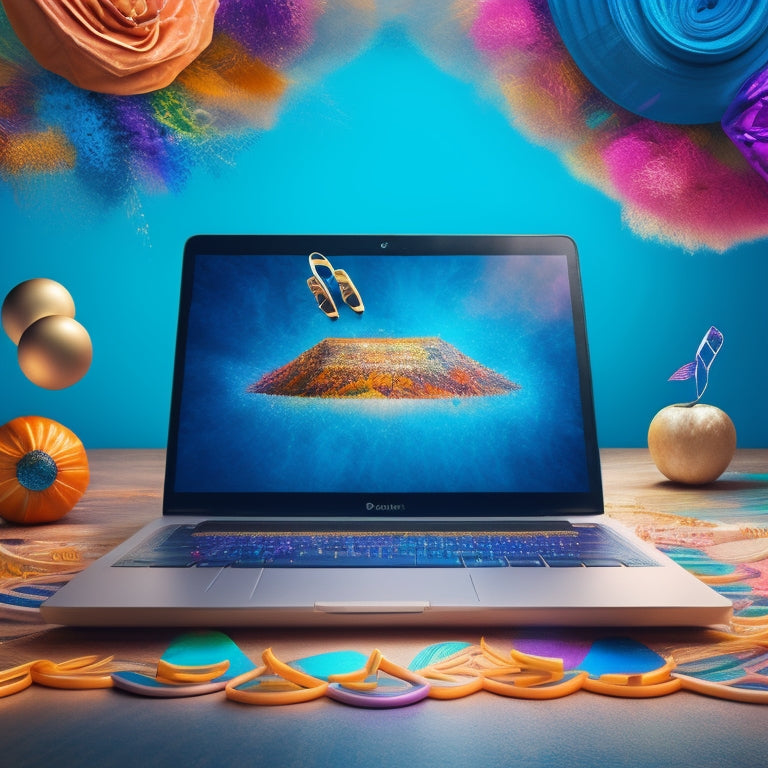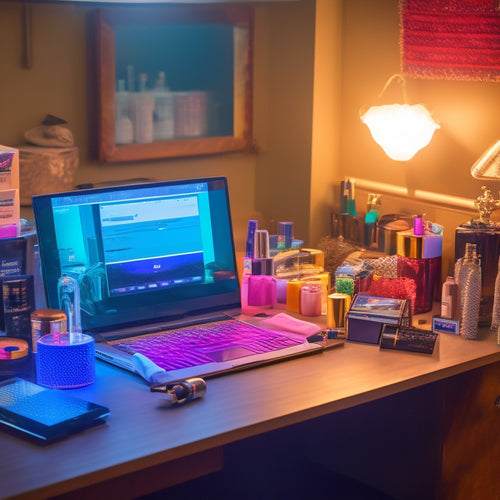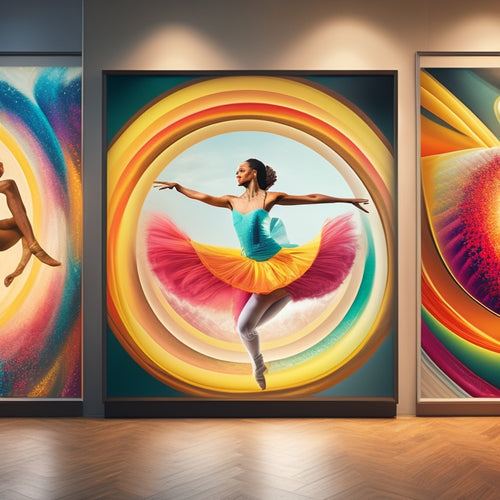
What Makes a Compelling Dance-Themed Online Course?
Share
When creating a compelling dance-themed online course, you'll want to define your target audience, crafting a learning experience that resonates with them. This means developing structured lesson plans, incorporating engaging video content, and providing personalized feedback mechanisms that cater to diverse learning styles and dance expertise. Incorporate interactive tools, set realistic practice schedules, and design visually appealing materials. Additionally, consider offering continuing education credits and fostering a supportive online community. By thoughtfully blending these elements, you'll create an immersive experience that sets your course apart - and that's just the beginning of what makes a truly compelling online course.
Key Takeaways
• A compelling dance-themed online course targets a specific audience, considering demographics, learning styles, and dance experience to tailor the content.
• Engaging video content with proper camera placement, lighting, and audio quality creates an immersive learning experience.
• A structured lesson plan with specific, measurable objectives and manageable choreography sections ensures students meet learning goals.
• Incorporating interactive tools like gamification, quizzes, and branching scenarios enhances student engagement and participation.
• Providing personalized feedback options, expert evaluation, and realistic practice schedules helps students track progress and improve their skills.
Define Your Target Audience
As you commence developing a dance-themed online course, identifying your target audience is essential, and the first step is to pinpoint who they are, what motivates them, and what they hope to achieve from your course.
To do this, conduct a demographic analysis to determine their age ranges, learning styles, and prior experience with dance. Are they beginners or seasoned dancers? Do they prefer online or in-person learning? What dance genres interest them, and what're their availability constraints? Understanding these factors will help you tailor your course to meet their needs.
Consider their learning goals: do they want to improve technique, increase flexibility, or prepare for performances? By asking these questions, you'll create a course that resonates with your audience and sets them up for success.
Create Engaging Video Content
As you create video content for your dance-themed online course, you'll want to focus on capturing the movement in a way that's engaging and easy to follow.
You'll need to pay attention to the technical aspects, too, like using high-quality audio to make sure that every step and beat is crisp and clear.
Capture the Movement
To create engaging video content that showcases your dance moves, you'll need to master the art of capturing movement on camera, and that starts with understanding the importance of proper camera placement and framing.
When choosing your camera angles, consider using a mix of close-ups, wide shots, and over-the-shoulder shots to keep your viewers engaged. Experiment with different frame rates to capture the nuances of your dance movements. For instance, a higher frame rate of 60fps or above can help to create a smoother, more realistic representation of your dance moves.
Additionally, pay attention to the lighting in your filming space. Soft, natural light can help to create a warm and inviting atmosphere, while harsh or dim lighting can detract from the overall quality of your video.
Use High-Quality Audio
You've mastered the art of capturing your dance moves on camera, now it's time to guarantee your audio is just as polished, as high-quality sound can make all the difference in creating an immersive video experience.
Subpar audio can be distracting, taking away from the overall impact of your dance instruction. On the other hand, crisp, clear sound can transport your students into the dance studio with you, making them feel like they're right there, moving alongside you.
To achieve professional-grade audio, invest in good quality microphones and headphones. Consider hiring an audio engineer or sound designer to make sure your audio is mixed and mastered to perfection. Don't underestimate the importance of sound design – it's what sets apart amateur from professional productions.
Showcase Dancer's Perspective
By capturing footage from the dancer's perspective, you'll create an immersive experience that puts your students in your shoes, making them feel like they're executing the choreography alongside you. This perspective allows your students to connect with you on a deeper level, fostering a sense of community and shared experience.
To make the most of this perspective, consider the following tips:
-
Get personal: Share your dance journey, and let your students in on your personal expression. This will help them connect with you on a deeper level and understand the emotional depth of the choreography.
-
Use close-ups: Capture the intricate details of your movements, such as the positioning of your hands or the expression on your face. This will help your students focus on the subtleties of the dance.
-
Experiment with angles: Don't be afraid to try out different camera angles, such as shooting from above or below. This will add visual interest to your footage and keep your students engaged.
- Make it real: Avoid overly rehearsed or scripted footage. Instead, focus on capturing the authenticity of your dance journey, including any mistakes or imperfections. This will make your students feel like they're part of your personal expression.
Develop a Structured Lesson Plan
As you develop a structured lesson plan for your dance-themed online course, you'll need to set clear objectives for each lesson, outlining what students will learn and achieve. This will help you create a roadmap for your instruction, ensuring that you're covering all the essential material.
Setting Clear Objectives
To create a dance-themed online course that truly resonates with students, setting clear objectives is crucial, and it all begins with developing a structured lesson plan that outlines what learners will achieve in each module. This will help you define what students will be able to do by the end of each lesson, and how you'll measure their progress.
To set effective objectives, consider the following:
-
Align learning outcomes with course goals: Guarantee that each lesson's objectives contribute to the overall course goals, so students stay focused on what's important.
-
Make objectives specific and measurable: Avoid vague goals; instead, define specific skills or knowledge students will acquire, and how you'll assess their mastery.
-
Establish performance metrics: Decide how you'll evaluate student performance, such as through quizzes, assignments, or peer feedback.
- Break down complex skills into manageable chunks: Divide complex dance skills into smaller, achievable components, so students can build confidence and mastery gradually.
Breaking Down Choreography
You'll create a structured lesson plan by breaking down choreography into manageable sections, allowing you to focus on specific dance skills and techniques that students need to master.
This approach enables you to craft a clear, step-by-step guide for your students to follow. Start by identifying the core components of the choreography, such as musicality analysis and choreo storytelling.
Then, dissect each section into smaller, bite-sized chunks, making it easier for students to grasp and execute the moves. By doing so, you'll create a clear roadmap for your students to follow, ensuring they understand the nuances of the choreography.
As you break down the choreography, consider the learning objectives and outcomes you want your students to achieve. This will help you tailor your lesson plan to meet their needs, ensuring they master the skills and techniques required to excel in the dance style.
Incorporate Interactive Learning Tools
By leveraging interactive learning tools, such as gamification, simulations, and virtual reality experiences, you can create an immersive and engaging learning environment that motivates students to dive deeper into the world of dance.
To take your online course to the next level, consider incorporating the following interactive elements:
-
Gamification elements: Use rewards, badges, or leaderboards to encourage students to complete exercises or master specific dance techniques.
-
Virtual scavenger hunts: Create an interactive experience where students have to find and identify different dance styles, techniques, or historical periods.
-
Interactive quizzes: Design quizzes that test students' knowledge of dance history, techniques, or styles, providing immediate feedback and suggestions for improvement.
- Branching scenarios: Develop interactive scenarios that simulate real-life dance performances, allowing students to make choices and experience the consequences of their decisions.
Set Realistic Practice Schedules
Establishing a practical practice schedule is crucial, as it helps you stay committed to your dance training and guarantees consistent progress. By setting realistic goals and allocating dedicated time for practice, you'll be able to manage your time effectively and make the most out of your online course. Remember, it's not about practicing for hours on end, but rather about being consistent and focused in your approach.
When setting your practice schedule, consider your daily routine, work commitments, and other responsibilities. Be honest with yourself about how much time you can realistically dedicate to practice each week. It's better to commit to 30 minutes a day, three times a week, than to try to cram all your practice into one marathon session.
Provide Personalized Feedback Options
As you design your dance-themed online course, you'll want to provide personalized feedback options that cater to each student's unique needs and learning style.
Instructor insights, such as video feedback or personalized notes, can help students refine their technique and build confidence.
Instructor Insights
You'll gain valuable insights from your instructor through personalized feedback options, which enable them to pinpoint areas of improvement and provide constructive guidance tailored to your learning needs. This level of attention allows you to refine your dance technique, address specific challenges, and develop a deeper understanding of your dance philosophy.
Here are just a few ways your instructor's insights can benefit your learning journey:
-
Dance philosophy alignment: Your instructor can help you understand how their teaching style and dance philosophy align with your own goals and aspirations, ensuring you're learning in a way that resonates with you.
-
Customized corrections: With personalized feedback, your instructor can identify areas where you can improve your technique, providing specific corrections that address your unique needs.
-
Progress tracking: Your instructor can monitor your progress, celebrating your achievements and identifying areas where you need more practice or refinement.
- Holistic learning: Through personalized feedback, your instructor can help you connect the dots between different dance styles, techniques, and philosophies, fostering a more all-encompassing understanding of dance as a whole.
Expert Evaluation Matters
Your instructor's expert evaluation is essential because it provides a fresh perspective on your dancing, helping you identify blind spots and areas for improvement that you might have overlooked on your own. This feedback is vital in refining your skills and preparing you for the industry. To make sure you receive constructive criticism, look for courses that incorporate peer reviews, industry standards, and mentorship models into their assessment criteria.
| Expert Evaluation | Benefits |
|---|---|
| Critical Feedback | Identifies areas for improvement |
| Talent Identification | Recognizes your strengths |
| Performance Metrics | Tracks progress and growth |
| Accreditation Process | Ensures industry standards |
| Mentorship Models | Provides guidance and support |
Design Visually Appealing Course Materials
To create an immersive learning experience, design course materials that incorporate vibrant colors, dynamic typography, and energetic imagery that resonate with your dance theme. This will help students connect with your course on a deeper level and stay engaged throughout their learning journey.
To achieve this, consider the following design elements:
-
Define your brand identity: Establish a consistent visual brand that reflects your dance theme, including a distinct color scheme, typography, and imagery style.
-
Select a palette of 3-5 core colors that evoke the emotions and energy of your dance theme, and use them consistently across all course materials.
-
Use high-quality, dance-related imagery that showcases different aspects of your dance theme, such as studio shots, performance photos, or illustrations.
- Choose typography that's modern, clean, and easy to read, and use it consistently across all course materials to create a cohesive look.
Offer Continuing Education Credits
By incorporating continuing education credits into your dance-themed online course, you can greatly enhance its appeal and credibility among professional dancers and dance enthusiasts. This is especially important for dancers who need to fulfill credit requirements for certification or licensure. By offering credits, you're providing a valuable incentive for dancers to enroll in your course and take their skills to the next level.
To make this happen, you'll need to research and comply with the credit requirements of relevant organizations, such as the National Dance Education Organization or the International Association of Dance Medicine and Science. This might involve meeting specific curriculum standards, instructor qualifications, and assessment protocols.
Foster a Supportive Online Community
How can you create an online environment that motivates dancers to learn from each other and stay engaged in your dance-themed online course? By fostering a supportive online community, you can encourage dancers to share their experiences, provide feedback, and learn from each other. This is vital in a dance-themed online course, where learners may feel isolated without a physical classroom.
To build a thriving community, consider the following strategies:
-
Encourage member profiles: Allow dancers to share their backgrounds, goals, and interests to facilitate connections and a sense of belonging.
-
Establish group norms: Set clear expectations for online etiquette, respect, and open communication to promote a positive and inclusive environment.
-
Foster social learning: Create opportunities for dancers to collaborate, provide feedback, and learn from each other's strengths and weaknesses.
- Assign virtual mentors: Pair experienced dancers with newer learners to provide guidance, support, and encouragement.
Establish a Post-Course Evaluation System
Once you've wrapped up your dance-themed online course, it's essential that you gather feedback from your dancers to refine your instruction and improve future iterations. This is where a post-course evaluation system comes in. By collecting feedback, you can identify areas of improvement, reinforce what's working, and make data-driven decisions to enhance the overall learning experience.
| Evaluation Method | Purpose |
| Survey Analysis | Identify areas of improvement and gauge student satisfaction |
| Feedback Loops | Encourage student reflections and provide targeted support |
| Progress Tracking | Monitor student progress and adjust instruction accordingly |
| Assessment Tools | Evaluate student learning outcomes and inform future course development |
Frequently Asked Questions
Can I Use Copyrighted Music in My Dance-Themed Online Course?
'When in doubt, throw it out' - don't risk copyright infringement! You can't use copyrighted music in your online course without permission. Look into music licensing or Fair Use provisions to make sure you're legally grooving to the beat.
How Do I Handle Students With Different Learning Styles and Abilities?
When teaching dance online, you'll encounter students with varying learning styles and abilities. To cater to them, you'll create Learning Profiles and adopt Adaptive Instruction, enabling you to tailor your approach and make sure every student shines.
Are There Any Specific Safety Guidelines I Should Follow for Online Dance Classes?
When teaching online dance classes, you'll want to prioritize injury prevention by providing clear instructions, encouraging warm-ups, and offering modifications for students. Don't forget to establish virtual etiquette, like respecting students' personal space and maintaining a distraction-free environment.
Can I Offer a Free Introductory Class to Promote My Online Course?
'You can offer a free introductory class to promote your online course, using it as a teaser to showcase your teaching style, Class Structure, and ability to spark Student Engagement, leaving students enthusiastic for more.'
How Do I Protect My Choreography and Intellectual Property Online?
Imagine a master chef's secret recipe stolen and sold online; you feel vulnerable, right? To protect your choreography, consider contract disputes and digital watermarking, ensuring your IP remains yours, and your dance legacy remains intact.
Related Posts
-

Why Dance Makeup Artists Need Online Solutions
As a dance makeup artist, you're likely struggling to attract clients and grow your business due to poor online visib...
-

7 Formal Dance Dresses for Black-Tie Events
For your next black-tie event, consider these seven stunning formal dance dresses that promise to turn heads. A class...
-

Dancers Delight: Stylish Wall Prints Available Now
Dancers Delight offers a curated collection of stylish wall prints that capture the essence of ballet, tap, and jazz,...


